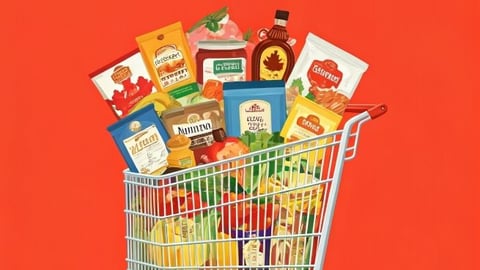Why made in Canada brands need to go beyond the label
Bob Froese was watching the Toronto Maple Leafs face off against the Florida Panthers when he felt inundated by made-in-Canada messaging. As chief creative officer of Toronto-based Bob’s Your Uncle, Froese is a strong supporter of brands embracing their Canadian identity amid today’s trade war with the U.S. But, even for an ad man, the red-and-white rush during the hockey game was a bit much.
“Really? Every brand? Every rink board? All the game, all the time? At one point, I started writing them down. I saw Made in Canada, Prepared in Canada, Made for Canadians, Authentically Canada, Served to Canadians…” says Froese.
Instead of making an impact, the messaging started to feel like wallpaper. “What does it even mean? It’s like a patriotic echo chamber, and no one is saying anything meaningful. I’ll call it lazy labelling versus real identity.”
Froese understands why brands are waving the maple leaf—and it makes sense, to a degree. “It’s born from economic nationalism. We have a common villain. Buying Canadian kind of feels like revenge.”
That’s powerful stuff for a brand, says Froese, but it’s a temporary emotion. And that, he adds, is where the real opportunity lies for brands. “This could be a watershed moment for Canada to finally take pride in the [products and brands] that come from here.”
As he wrote on a LinkedIn post venting his frustration after the game, the key is to “stop leaning on the flag and start leading with story.”
That shift starts with instilling genuine pride in Canadian-made products. “Right now, we’re all doing it to be supportive. But it’s not based on an innate belief that our products might be better. Otherwise, we would have been buying them before.”
He points to his recent stay in France as an example of what real consumer pride looks like. “There, buying local isn’t political—it’s instinctual,” he says. “They don’t need a trade war to value their own products—they fundamentally believe they’re superior. They’re emotionally connected to it. It’s cultural currency... That’s the shift we need.”
Support is high, but will it last?
While the Buy Canadian movement began as reactionary, research points to a real shift in purchasing behaviour—underlining the need for brands to do more than capitalize on the moment.
A recent study by insights consultancy Leo & Dragon found that 57% of Canadians believe it’s important to buy Canadian and 77% have adjusted their shopping behaviours.
In the past six months, 57% of Canadians say they have switched to Canadian brands, while 49% have reduced American brand consumption—shifts they expect will continue for the next six months (60% and 50%, respectively). The top three categories where it’s most important to buy Canadian are dairy, fresh fruits and vegetables, and frozen foods.
READ: How grocery shoppers are standing up to the U.S.
Joseph Chen, founder and CEO at Leo & Dragon, notes that consumers used to view shopping locally as more expensive. But now, they’re “putting country over price tag” and are willing to pay more for Canadian-made products, particularly when it comes to food and beverages. In the survey, 59% of respondents say they’re willing to pay more (about a 7% premium) for Canadian products.
“In general, Canadians are a bit more hesitant to invest money in something that’s local because they know it’s going to be a bit more expensive,” Chen says. “But because of the [Buy Canadian] movement, we’re seeing that people are more actively willing to spend more for Canadian-made.”
Turning pride into purpose: How brands can stand out
As the patriotic push in the grocery aisles shows no signs of slowing down, how can brands move beyond the maple leaf?
Rita Steinberg, group media director at Toronto-based Fuse Create, emphasizes the importance of “authentic storytelling, transparency and building emotional connections” outside of brands’ retail presence.
“Yes, you can have a made-in-Canada label on store shelves, but if a consumer goes to any other platform—whether it’s your website or your social media presence—that needs to weave through all of your communication and activity,” Steinberg says.
Beyond highlighting their origin story, brands can connect with consumers by communicating their purpose and impact. That could mean showcasing sustainability practices, ethical sourcing and responsible consumption, Steinberg says—factors that resonate strongly with gen z and millennial consumers.
READ: Canadians willing to pay more for homegrown goods, survey finds
“If you’re looking at a slightly older demographic, brands can highlight local community and history—helping people understand where the brand comes from,” she says. “Successfully integrating that Canadian identity into your brand is critical, versus simply overlaying that messaging on top of your existing positioning.”
Understanding what makes a brand matter to Canadians is where Froese believes many homegrown companies fall short. Take potato chips, for example. He notes that Canada is home to heritage brands like Old Dutch and Covered Bridge, which he describes as “locally crafted, not expensively priced, fantastic potato chips.” But they’re not the go-to potato chips for most Canadians, who default to Lay’s or Doritos.
That’s due in part to Canada’s retail and distribution environment, Froese notes, which is dominated by a handful of large retailers, doesn’t favour small brands and gives large brands—with more resources—an advantage in buying shelf space.
“We almost have to reverse engineer how we bring these products to market and how we support them,” he says. “It’s very difficult for them to compete.”
What’s the solution? “They need to have more confidence—in how they communicate and how they go to market—and be bolder.”
Marketing investment is also key. Froese observes that American entrepreneurs have a different mindset, viewing marketing as an essential line item—as vital as the machine that makes the chips.
“In Canada, it’s like, ‘how can we avoid spending that money?’” he says. “But that’s what will get people to find you and to believe in you.”
Looking ahead, Froese says the Buy Canadian movement has staying power, but only if brands are willing to go deeper. “I don’t think it can last with ‘I am Canadian,’” he says. “It has to go beyond that.”





